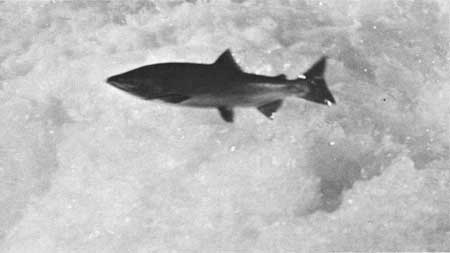|
OLYMPIC National Park |
 |
Wildlife (continued)
FISH
The Olympic Peninsula is noted for its many miles of beautiful streams. This water provides an abundant world for fishes and gives joy to the fisherman. In these coastal streams the fisherman's fishes are trout and their relatives, the salmon.
Trout found in the streams include cutthroat, rainbow, brook, Dolly Varden, and steelhead. The steelhead spends the greater part of its life in the ocean, but enters fresh-water streams to reproduce. After spawning, it returns to salt water. During its life span it may make several winter spawning trips up the fresh-water streams. The lives of sea-run cutthroat follow the same pattern, except they spawn in autumn.
In autumn or spring, salmon of several species swim up-stream, driving hard to reach the tributaries where they were hatched. Their mission is to spawn. This is their grand and final act, for unlike the steelhead, they do not return to the sea after spawning, but die. Sport fishing for salmon is done chiefly in salt water, and the waters around the Olympic Peninsula have become famous for the excellent salmon sport fishing they afford.
Some mountain lakes contain rainbow and brook trout. Lake Mills, which is impounded water, contains rainbow, brook, and Dolly Varden trout.
The largest lake in the park, Lake Crescent, formerly contained two varieties of trout that have not been found to be native anywhere else. These were the Beardslee and the Crescenti, varieties of the rainbow and cutthroat, respectively, which frequently reached a weight of between 10 and 15 pounds. These varieties of trout probably no longer exist in the pure state. Recent studies indicate that present trout stocks, contaminated by plantings of hatchery fish that were made before the park was established, are now hybridized from cross breeding. This is the usual story that follows upon man's interference with natural waters—a story which has been repeated over and over again in the United States.
A license is not required for fishing in the park. There are regulations, however, pertaining to the season, open water, catch limit and method of fishing. A copy of these regulations may be obtained at the superintendent's office or at a park ranger station.
 A COHO SALMON JUMPING THE RAPIDS OF THE SOLEDUCK RIVER. |
OTHER ANIMAL LIFE
In addition to mammals and birds there are other animals which, though smaller and with less apparent personality, may be equally interesting. They are part of the native wild fauna of the park and are accorded the same protection as the larger forms. The few listed below are frequently seen along trails.
NORTHWESTERN TOAD. This warty animal can be distinguished by the light-colored line that runs down its back. It is common on forest trails, but blends so well with the ground that it may not easily be seen.
PACIFIC TREEFROG. This delicate, moist animal can be identified by the adhesive pads on its toes with which it can cling to smooth surfaces. It has a black line on each cheek, running through the eye. The eyes have a bronze iridescence.
PACIFIC COAST NEWT. This attractive species of salamander can be identified easily by its color—brown on top and orange underneath. They are commonly seen in the spring when they congregate in ponds and small lakes to spawn.
There are several other species of salamanders in the park that live among the rotting logs in the damp woods.
GARTER SNAKE. This is probably the only snake you will see. There are no poisonous snakes on the Olympic Peninsula.
COMMON SNAIL. If not disturbed, this shelled creature of the woods can be seen moving about carrying its "house" on its back. The shell is about an inch across. The eyes are on the ends of two long stalks, enabling the snail to see over obstructions.
COMMON SLUG. The grayish-green slug with its shiny mucous track is abundant on many forest trails. Some of these slugs are blotched with black.

|

|
| NPS History | History & Culture | National Park Service | Contact |
|
Last Modified: Sat, Nov 4 2006 10:00:00 pm PST |


